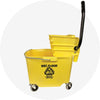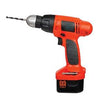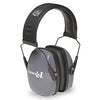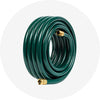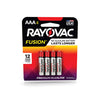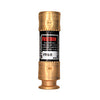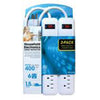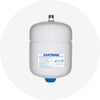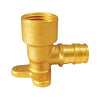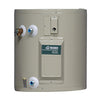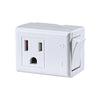How to prevent frozen pipes and what to do if they have already frozen
∙ min read

When temperatures drop, one of the biggest challenges faced by business owners and plumbers alike is preventing frozen pipes, a problem that can lead to costly damage and disruptions. With this guide, you’ll learn the best practices to keep pipes from freezing, helping you maintain project continuity, protect infrastructure, and ensure client satisfaction. Whether you work in residential or commercial buildings, these tips will help you stay ahead when cold weather hits your area.
What are the long-term benefits of investing in pipe insulation?
Investing in commercial building pipe insulation offers long-term benefits beyond just preventing damage. Some of the most important advantages include:
- Prevention of damage
- Energy savings
- Extended pipe lifespan
- Contribution to eco-friendly practices
- Regulatory compliance
- Improved indoor environment
- Risk reduction
How to prevent pipes from freezing in commercial buildings
To prevent pipes from freezing, applying a combination of preventive strategies tailored to the building's characteristics and needs is crucial, minimizing the risk of costly damage and disruptions in commercial projects.
Pipe insulation
Using specific insulation materials like cotton, foam, or fiberglass helps maintain a stable temperature around the pipes, protecting them from freezing temperatures. Be sure to cover exterior pipes and those in unheated areas, such as basements, garages, and attics.
Heat tape installation
Heat tape is ideal for commercial installations where pipes are exposed to extreme temperatures. These tapes adhere to the pipes and provide controlled heat to prevent the water inside from freezing.
Ambient temperature control
Automated systems can also help prevent pipes from freezing in commercial environments. Keeping areas where pipes are located above 32 °F (0 °C) is essential. Make sure to seal any air leaks in windows, doors, and walls, and use heating in critical areas to avoid sudden temperature drops.
Constant water flow
Allowing a small trickle of water to flow through the pipes can prevent ice formation in freezing conditions. This technique is particularly useful for pipes near exterior walls or those without sufficient insulation.
Regular maintenance
Performing inspections and routine maintenance before freezing arrives is crucial in identifying vulnerable areas. Repairing leaks or replacing corroded sections can prevent blockages or bursts. Additionally, if some areas of the building won’t be in use during winter, draining the pipes and water systems in those zones will reduce the risk of freezing.
Temperature Sensors
Installing temperature sensors on pipes can provide timely alerts if temperatures drop dangerously close to freezing. This type of technology allows for quick intervention before any significant damage occurs.

What to do if pipes freeze in a large building
If pipes freeze, the maintenance team must act quickly to prevent significant damage, such as burst pipes or flooding. During and after the incident, informing building occupants about the situation, the steps taken, and any potential impacts on the water supply is crucial. This helps maintain safety and prevents improper use of the facilities until the issue is resolved.
Here are some of the recommendations from the American Red Cross for thawing frozen pipes:
- The first step is to locate the affected pipes. They may be in areas with lower temperatures, such as basements, attics, or near exterior walls. Signs of freezing include a lack of water flow from sure faucets or noticeably colder sections of the pipe.
- Before taking any action to thaw the pipes, shutting off the water supply in the affected sections is essential. This will help prevent flooding if the pipes have cracked due to freezing.
- Once the frozen pipes are located, the maintenance team can apply heat safely. Some options include:
- Electric heat tape
- Hot air blowers or heat guns
- Towels soaked in hot water
It’s important to note that open flames, such as blowtorches, should never be used, as they pose a fire risk and can damage the pipes.
- Next, open the faucets connected to the frozen pipes. This will help relieve built-up pressure and allow water to flow once the pipes begin. Additionally, the flow of water will aid in the thawing process.
- Monitoring the system for leaks or breaks is essential as the pipes thaw. If a leak is detected, the water supply should remain shut off, and repairs should be made immediately.
- If the freezing has caused cracks or breaks, the team should be prepared to make immediate repairs. This may involve replacing damaged pipe sections or making temporary repairs with appropriate materials until a permanent fix can be made.
- Finally, the maintenance team should document the incident, detailing the affected areas, actions taken, and any repairs made. This helps with future interventions and can also be useful for internal reports or insurance claims.
These combined actions ensure an effective response to frozen pipes in large buildings, minimizing risks and potential damage.
Find everything you need for severe weather at Max Warehouse
At Max Warehouse, we offer the best types of pipe insulation to ensure frozen pipes don’t catch you off guard in your building or commercial environment. If you have any questions, our experts will help you choose the right products for each type of pipe you manage.
We also offer a program called Max Pro, where you can access special pricing, volume discounts, personalized service, and faster shipping. This program is designed for professionals like you, so sign up now and start enjoying these benefits.
Safeguard your pipes against freezing with expert insulation tips
Sources:
- https://www.travelers.com/resources/business-topics/facilities-management/preventing-frozen-pipes-for-businesses
- https://savingwithcems.com/blog/three-benefits-of-energy-efficient-pipe-insulation/
- https://www.redcross.org/get-help/how-to-prepare-for-emergencies/types-of-emergencies/winter-storm/frozen-pipes.html#:~:text=If%20you%20will%20be%20going,lower%20than%2055%C2%B0%20F.
- https://www.nbcchicago.com/news/local/what-should-you-do-if-your-pipes-freeze-in-the-extreme-cold-here-are-several-steps-you-can-take/3327200/


